1. 서론
사람의 미각평가가 불가한 시료의 맛을 정성 및 정량적인 수치로 맛을 평가하는 방법으로 전자혀를 통한 방법이 수행되고 있다(Legin 등, 2000). 전자혀에는 혀를 대신한 인공 지방질 막이 부착되어 있고, 시료에 들어있는 각종 물질들에 반응하는 센서가 들어있어 이러한 센서를 소재에 담그면 맛을 가진 물질을 흡수하며 인간과 같이 인공 지방질 막의 막전위 변화가 일어난다. 각각의 센서에서 나온 신호와 시료의 맛을 나타내는 성분 간의 감응도를 측정하여 수치화하는 작업을 거치게 되어 맛을 구별하고 맛을 종합적으로 판단할 수 있다. 전자혀가 사람의 혀보다 기능적으로 뛰어난 점은 일정한 성분에 언제나 정확히 반응하는 장점이 있어, 이러한 특성에 따라 식품소재산업분야에서는 식품소재의 맛을 정량화하고 객관화하는 분야에 활용되고 있다(Kim과 Park, 2016; Kiyoshi, 1998).
고려인삼(Panax ginseng C.A. Meyer)은 면역력 증진, 항당뇨 및 항피로 효능이 널리 알려져 있는 우리나라의 대표적인 생약재이자 식품소재 식물자원이나(Arring 등, 2018; Chen 등, 2019; Choi, 2008; Ratan 등, 2021), 쓴맛을 가져 기호상 부정적인 요소로 작용하고 있으며 이러한 쓴맛을 감소시키기 위한 가공공정개발들이 요구되고 있다. 인삼의 주요한 생리활성 물질로는 ginsenosides, polyacetylenes, 페놀성 물질, 알칼로이드, 아미노산 및 무기원소, 플라보노이드 등이 알려져 있다(Hwang과 Choi, 2006; Hyun 등, 2020; Lee 등, 2020; Yeo 등, 2017). 인삼의 쓴맛에 대한 연구는 물리적, 화학적으로 추출 및 가공과정을 달리하여 관능적으로 쓴맛을 감소시키는 방법에 대한 연구가 진행된 바 있다(Choi 등, 2016; Tamamoto 등, 2010). 그러나 윤리상, 건강상의 문제로 사람에 대한 직접적인 관능검사가 어려운 각각의 개별 인삼성분의 쓴맛에 대한 연구 보고는 부족한 실정이다. 이에 본 연구에서는 전자혀를 이용하여 인삼의 주요성분의 쓴맛을 측정함으로써 인삼 쓴맛 물질 규명연구를 진행하여 인삼 쓴맛 저감화 공정연구에 활용 가능한 기초자료로 제시하고자 하였다.
2. 재료 및 방법
Ginsenoside Rb1, Rg1, Rg2, Rg3, Re, Rc, Rh1와 salicylic acid, p-coumaric acid, ferulic acid, vanillic acid, cinnamic acid, syringic acid, 4-hydroxybenzoic acid, m-coumaric acid, harmane, caffeine은 Sigma-Aldrich사(St. Louis, MO, USA)에서 구입하여 사용하였고 panaxydol과 panaxynol은 Chemfaces사(Wuhan, China)에서 구입하여 사용하였다.
Ginsenoside Rb1, Rg1, Rg2, Rg3, Re, Rc, Rh1는 주정 45%에 녹여 각각 0.1% 진세노사이드 용액을 5종을 제조하였다. 인삼 페놀성 성분인 salicylic acid, p-coumaric acid, ferulic acid, vanillic acid, syringic acid, 4-hydrobenzoic acid, m-coumaric acid와 카르복실산 성분인 cinnamic acid는 주정 45%에 녹여 각각 0.1% 용액 10종을 제조하였다. 인삼의 폴리아세틸렌 성분인 panaxydol, panaxynol과 인삼의 알칼로이드 성분인 harmane, caffeine 또한 45% 주정에 녹여 각각 0.1% 용액을 제조하였다.
충청남도 금산에서 구입한 4년생 수삼(Panax ginseng C.A. Meyer, 고려인삼)을 이용하여 백삼과 홍삼(증숙인삼)을 제조하였다. 백삼은 수삼을 50°C에서 36시간 열풍 건조하여 제조하였으며 홍삼은 수삼을 95°C에서 3시간 증숙 후 50°C에서 36시간 열풍 건조하여 제조하였다. 백삼과 홍삼시료를 분쇄하고 70% 에탄올을 사용하여 3시간씩 2회 추출후 감압농축 및 동결건조하여 백삼 및 홍삼 추출물을 제조하였다.
제조된 인삼의 진세노사이드, 페놀성, 폴리아세틸렌, 알칼로이드 성분 용액 및 인삼 추출물을 시료액으로 사용하였고 보정액으로는 10 mM 염화칼륨 수용액을 사용하였다. 미각센서 기기는 SA402B(Insent, Atsugi, Japan)를 이용하였으며, 센서는 foodstuff sensor 5종(CT0, C00, AAE, CA0 및 AE1)을 장착하고 4회 반복 측정하였다. 측정결과는 분석 소프트웨어(Taste Analysis Application, Insent, Japan)를 이용하여 산출하였다. 표시 단위는 분석 소프트웨어에서 산출되는 미각정보 단위(taste information unit)로 하였다.
Ginsenoside 함량은 HPLC system(Jasco, Tokyo, Japan)을 사용하여 분석하였다. μBondpack C18 column (10 μm, 300×3.9 mm, Waters, Milford, MA, USA)을 사용하여 이동상은 증류수(용매 A)와 acetonitrile(용매 B)을 초기에 용매 A 80%에서 70분 후 용매 A 0%로 gradient를 주어 용출하였다. 용출속도는 1.0 mL/min, column의 온도는 25°C로 유지하였으며 시료의 검출은 203 nm에서 측정하였다. 분석용 추출물 시료는 10 mg/mL로 메탄올에 녹인 후 0.45 μm syringe filter(Millipore, Bedford, MA, USA)로 여과하여 사용하였다.
3. 결과 및 고찰
전자혀를 통한 ginsenoside 종류별 쓴맛의 평가에 있어 standard solution으로 인삼 중 가장 높은 함량을 지니고 용해성이 좋은 Rb1으로 설정하였다. 인삼의 주요 ginsenoside인 Rb1의 0.1% 용액에 대하여 전자혀 장치에 의한 쓴맛을 측정한 결과 6.7로 나타나 가장 강도가 높았고 ginsenoside Rg1, Rg3, Re, Rc 0.1% 용액의 각각의 쓴맛을 측정한 결과는 5.9-6.2로 나타났으며, Rg2, Rg3, Rh1의 쓴맛 강도가 5.0-5.4로 상대적으로 낮았다(Fig. 1). 화학구조적으로는 배당체인 ginsenoside에 결합된 당이 적은 ginsenoside의 쓴맛 강도가 상대적으로 낮은 경향을 나타내었다. Ginsenoside의 쓴맛 강도 측정 결과를 전체적으로 볼 때, ginsenoside의 쓴맛 강도는 비교적 높은 경향(5.0-6.7)을 나타내어 ginsenoside는 인삼의 쓴맛에 전반적인 영향을 주는 성분으로 확인할 수 있었다.
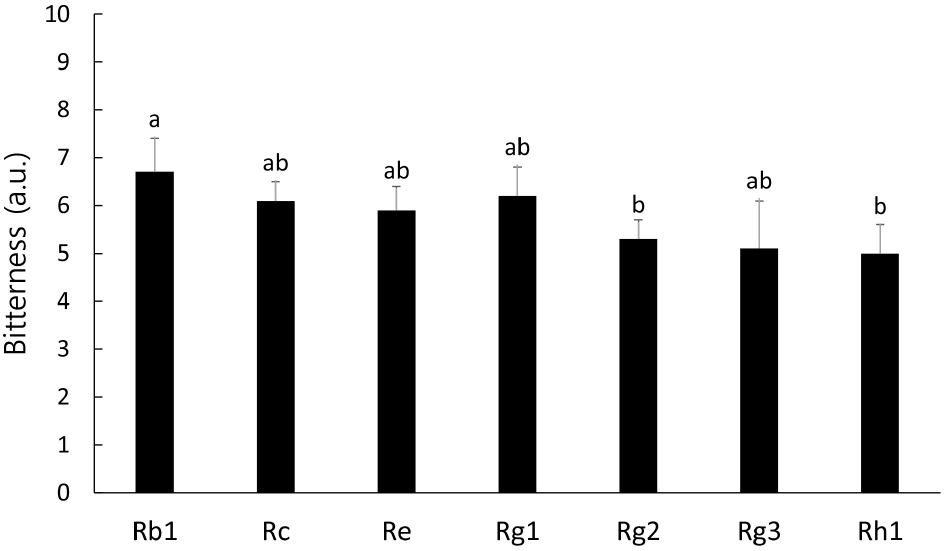
전자혀를 이용하여 인삼의 주요 페놀성 성분별 쓴맛을 측정한 결과 2.4-3.1점으로 쓴맛의 강도가 낮게 나타났다. 따라서 페놀성 성분은 인삼의 쓴맛에 큰 영향을 주지 않는 것으로 판단된다(Fig. 2). 또한, 인삼의 주요 폴리아세틸계 성분인 panaxynol, panaxydol의 쓴맛을 전자혀를 이용하여 측정한 결과 각각 2.9, 4.0으로 쓴맛 강도값이 낮게 나타나 이 역시 인삼에 쓴맛에 있어 주요요인으로 작용하는 성분이 아닌 것으로 확인할 수 있었다(Fig. 3).
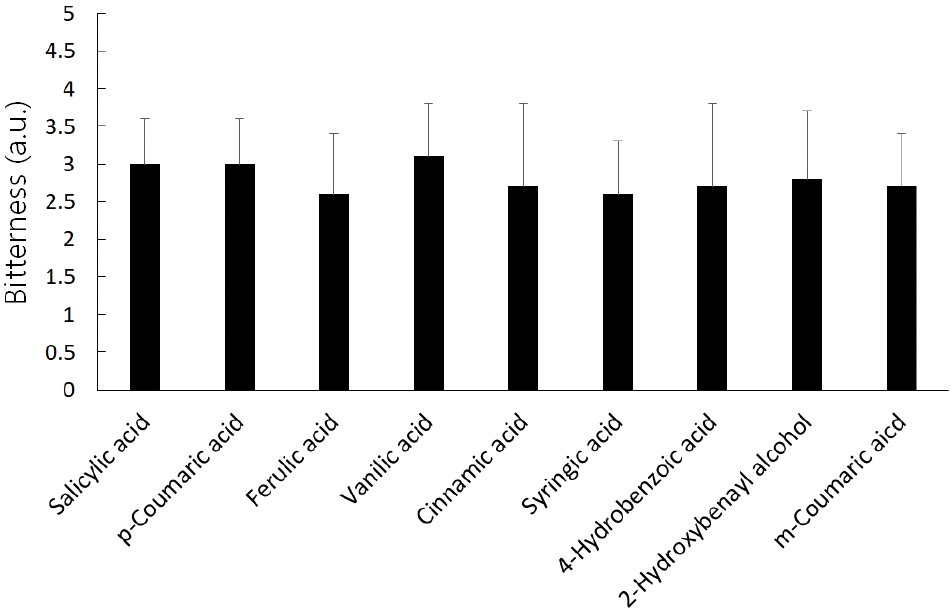
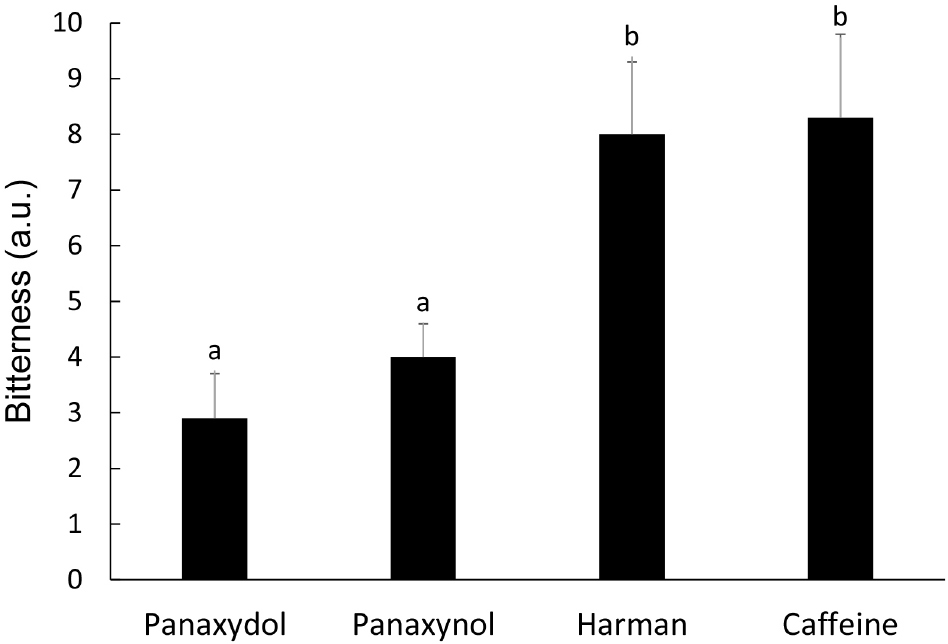
인삼의 알칼로이드 성분인 harmane, caffeine의 쓴맛강도를 전자혀를 이용하여 측정한 결과 각각 8.0, 8.3의 값을 나타내어(Fig. 3) 5.0-6.7인 진세노사이드보다도 높다. 따라서 이들 알칼로이드 성분은 분석한 성분 중 가장 쓴맛이 높은 성분으로 판단된다(Fig. 4). 또한, Herraiz(2004)와 Pfau 등(2004)은 harmane 성분이 독성을 나타낸다고 보고한 바 있어 알칼로이드 성분을 제거한다면 독성과 쓴맛을 동시에 낮출 수 있을 것으로 기대되나, Filipiak-Szok 등(2017)의 보고에 따르면 고려인삼(P. ginseng C.A. Meyer) 추출물 내 harmane 함량은 미검출 수준이고, caffeine 함량은 1.42 mg/100 g으로 함유량이 매우 낮아 실질적인 인삼의 쓴맛에 미치는 영향은 미비할 것으로 판단된다.
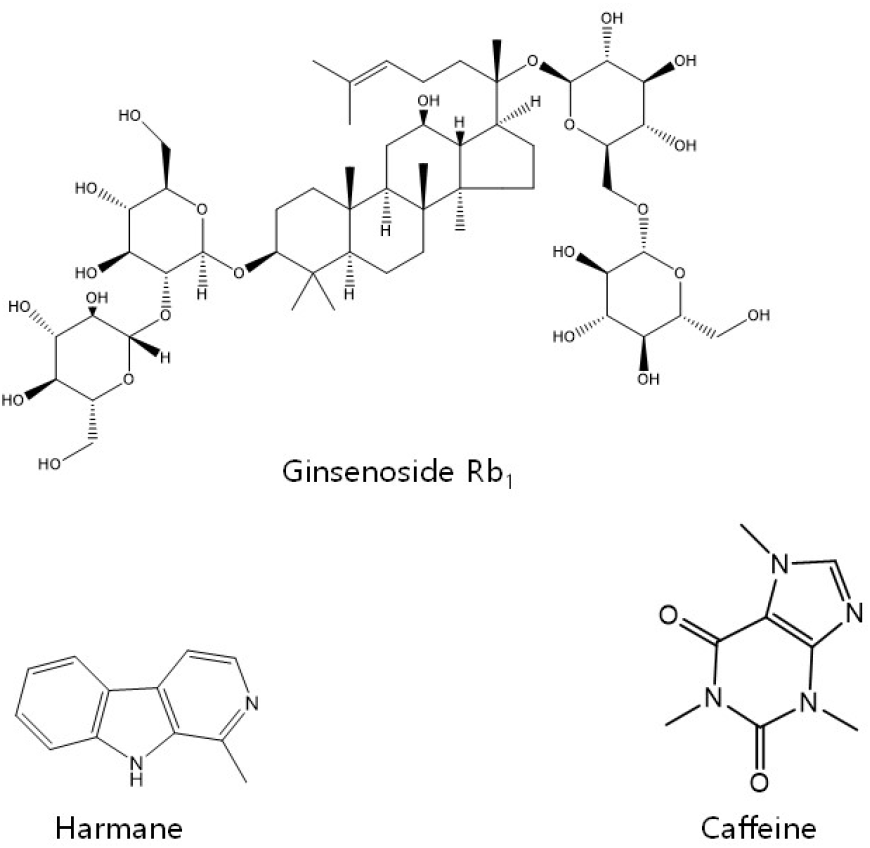
제조된 백삼과 홍삼 추출물 내 ginsenoside 함량을 측정한 결과 백삼에 함유된 주요 ginsenoside인 Rb1, Rc, Rd, Rg1이 홍삼 증숙 과정으로 인해 줄어들고 ginsenoside Rg2, Rg3, Rh1의 함량이 늘어난 것을 확인할 수 있었으며, 이는 백삼과 홍삼의 ginsenoside 함량을 비교한 Nam (2005)의 연구보고와 일치하였다. 또한, 분석된 ginsenoside 함량의 총합은 백삼에 비해 홍삼에서 소폭 증가하였다(Table 1).
제조된 백삼과 홍삼의 쓴맛 강도를 전자혀를 이용하여 10 mg/mL 농도에서 측정한 결과 백삼 추출물의 쓴맛강도는 5.9인 데 비해 홍삼 추출물은 쓴맛 강도 4.8을 나타내었다(Fig. 5). Table 1의 주요 ginsenoside 함량분석 결과를 볼 때 전체적인 ginsenoside 함량은 홍삼이 높으나 쓴맛 강도가 백삼보다 비교적 낮은 것은 백삼(ginsenoside Rg2+Rg3+Rh1: 0.24 mg/g)보다 홍삼(ginsenoside Rg2+Rg3+ Rh1: 3.18 mg/g)에 많이 함유되어 있는 ginsenoside Rg2, Rg3, Rh1의 쓴맛 강도가 다른 ginsenoside에 비하여 낮은 것이 영향을 미칠 수 있는 것으로 판단된다(Fig. 1). 다만 인삼에는 ginsenoside 이외에 여러 가지 일반성분과 영양성분도 함유되어 있으므로 이들의 쓴맛에 미치는 영향에 대한 추가적인 연구가 필요하다고 사료된다.
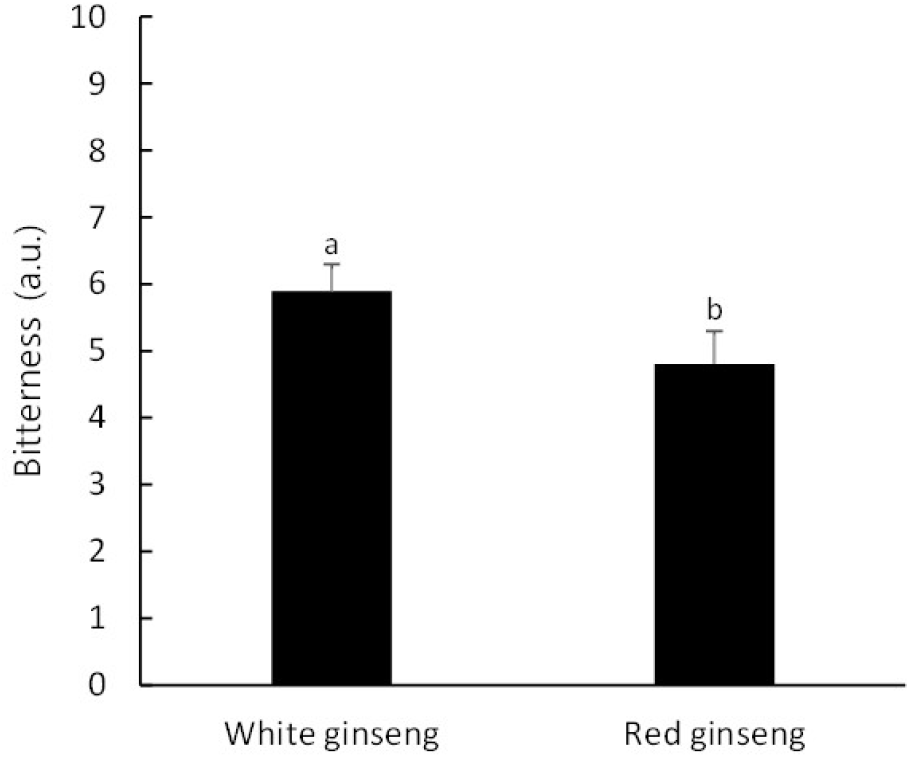
4. 요약
인삼의 쓴맛 성분을 규명하기 위해 전자혀를 이용하여 여러 인삼성분의 쓴맛 강도를 측정한 결과, ginsenoside와 알칼로이드 성분의 쓴맛 강도가 높은 것으로 나타났다. 이 중 알칼로이드 성분은 고려인삼 내 함량이 낮아 인삼의 쓴맛에 실질적인 영향이 미비할 것으로 판단되며 함량이 높은 ginsenoside가 쓴맛에 미치는 영향이 클 것으로 사료된다. Ginsenoside는 인삼 고유의 활성성분으로 큰 폭의 ginsenoside 함량감소는 인삼의 고유 기능성에 부정적인 영향을 줄 수 있으므로, 기호성을 높여 시장성을 확대하고자 인삼의 쓴맛을 경감하기 위하여는 ginsenoside Rb1을 비롯한 인삼 내 함량이 높고 쓴맛이 강한 ginsenoside를 다른 ginsenoside로 전환시키는 가공방법을 개발하는 것이 바람직할 것으로 판단된다. 또한, 전자혀와 실제 사람의 미각과는 차이가 있을 수 있으므로 향후 사람의 미각에 대한 직접적인 추가 검증 연구도 필요하다고 사료된다.










